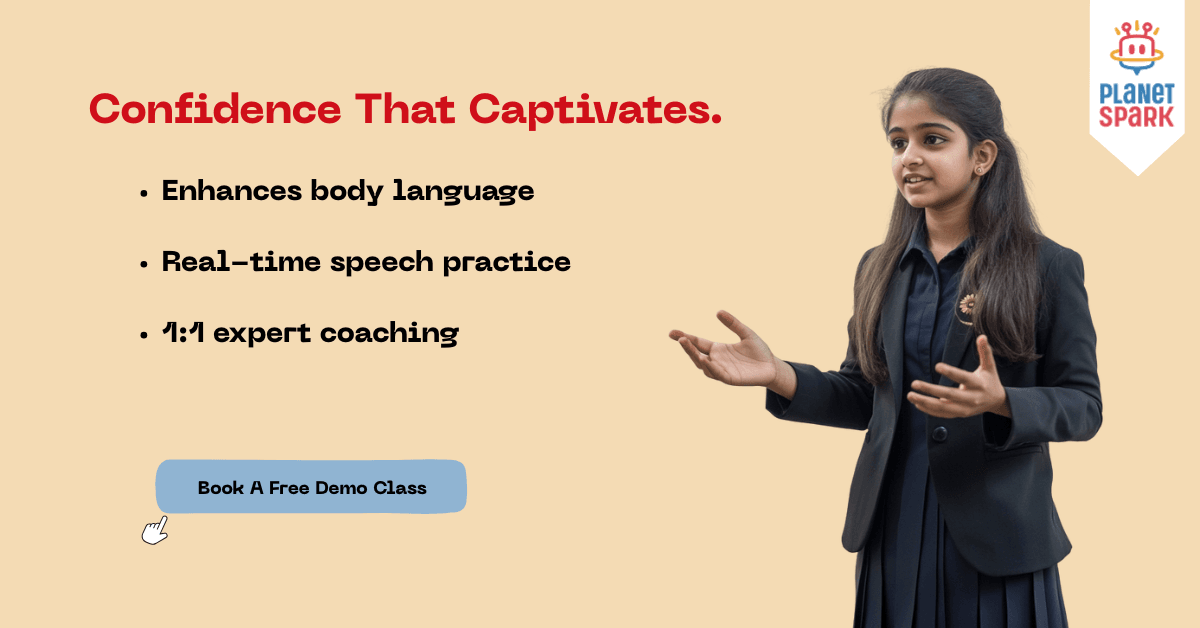Mastering the art of pausing transforms not just how you speak — but how you feel while speaking. Confident speakers understand that silence doesn’t mean uncertainty; it reflects control and composure. When you pause deliberately, you show that you are thinking before speaking, which enhances credibility. It also helps eliminate filler words like “uh,” “um,” and “like,” which often make speakers sound nervous or unsure.
Key benefits of mastering pauses include:
Improved clarity: Listeners have time to understand and process your message.
Reduced anxiety: Pauses allow you to breathe, calm your thoughts, and regain focus.
Better audience connection: Intentional pauses help listeners stay engaged and anticipate what’s next.
By learning to embrace silence, you project confidence, professionalism, and emotional intelligence — the hallmarks of great communicators.
Help your child master confident communication, enroll now at PlanetSpark!
How Pauses Improve Storytelling and Public Speaking
In storytelling and public speaking, pauses are powerful tools that shape rhythm, tone, and emotion. A well-placed pause can turn a simple sentence into a memorable moment, allowing the audience to fully absorb what was just said. When a speaker tells a story, silence between key phrases creates anticipation, it keeps listeners engaged, waiting for what comes next. For example, a dramatic pause before revealing a crucial event in a story can make the impact far greater than words alone.
Public speakers also use pauses to emphasize transitions, giving the audience a chance to reflect before moving to the next idea. Pauses control pacing, prevent monotony, and add authenticity. Without them, even strong content may sound rushed or robotic. By learning to pause purposefully, speakers create a connection, guiding the audience’s emotions through every word and silence — making the message not just heard, but felt.
The Difference Between Natural and Forced Pauses
Not all pauses are created equal some enhance communication, while others interrupt it. Natural pauses occur effortlessly, usually aligning with punctuation or thought breaks. They sound smooth and help the listener follow the speaker’s flow. Forced pauses, however, feel awkward or unintentional often caused by nervousness, forgetting words, or breaking mid-sentence. These can distract the listener and reduce credibility.
Here’s how to distinguish and refine your pauses:
Natural pauses happen at logical points — after completing an idea or before introducing a new one.
Forced pauses occur mid-thought, breaking rhythm or causing confusion.
To sound natural, breathe and think in phrases, not single words.
Practice reading aloud to identify where pauses should naturally fit.
By learning the difference, you can transform silence from an uncomfortable gap into a powerful communication technique that adds rhythm, control, and authenticity to your speech
Using Pauses to Emphasize Key Points
Just as writers use punctuation and formatting to highlight ideas, speakers use pauses to emphasize meaning. A deliberate pause before or after an important phrase signals to listeners “Pay attention, this matters.” For instance, saying, “The secret to success… is consistency,” gives the pause the power to underline your message.
Pauses draw attention to words that might otherwise get lost in a fast-paced delivery. They also help speakers sound more deliberate and persuasive. In fact, effective speakers often use three-second pauses before making strong statements, allowing the audience to prepare mentally for the impact.
To use pauses for emphasis:
Pause before revealing critical points.
Stop briefly after a strong statement to let it resonate.
Avoid stacking pauses too close together — timing is key.
Mastering this balance makes speech more memorable, rhythmic, and authoritative, helping your message truly stand out.
Give your child the gift of powerful communication, register for a free trial at PlanetSpark!
Pausing for Emotional Connection with the Audience
A well-timed pause can evoke more emotion than a long explanation. In both storytelling and everyday conversations, silence helps the audience connect deeply with the speaker’s feelings. When you pause after a heartfelt sentence “I realized… I wasn’t alone anymore” — it lets the emotion breathe. It gives listeners time to reflect, empathize, and emotionally align with the message.
Pauses also help convey sincerity. In personal speeches, interviews, or emotional discussions, silence can communicate compassion, humility, and thoughtfulness. Instead of rushing through words, speakers who pause show emotional awareness and authenticity.
In professional settings, pausing before responding demonstrates respect and composure, especially during sensitive conversations. When used intentionally, pauses make the audience feel valued — that their understanding matters. In short, silence is the bridge between emotion and expression, turning a simple talk into a meaningful human experience.
The Relationship Between Breathing and Pausing
Effective pausing starts with controlled breathing. Every pause in speech is naturally tied to a breath, it’s how our body maintains rhythm and clarity. Learning to synchronize your breathing with your words helps you pause naturally without sounding forced. Deep, mindful breathing calms nerves, slows speech pace, and improves confidence.
Here’s how breathing enhances pauses:
Breathing before speaking prevents rushing and sets a steady tone.
Inhaling during pauses helps reset your focus and energy.
Controlled exhalation keeps sentences smooth and flowing.
Diaphragmatic breathing (from the stomach, not the chest) increases control over voice and rhythm.
Professional speakers often train themselves to breathe between thoughts, not words — allowing their delivery to sound effortless. The more comfortable you become with your breath, the more naturally your pauses will align with meaning, making your speech sound fluent, composed, and confident.

Why Choose PlanetSpark?
At PlanetSpark, we believe that communication is more than just speaking, it’s about rhythm, emotion, and expression. Our scientifically designed English-speaking programs help learners master not only grammar and vocabulary but also the power of pausing, tone, and pacing, the true secrets of confident speech.
- Personalized Learning: Every learner has a unique way of expressing themselves. PlanetSpark’s one-on-one and small-group sessions are tailored to help students use pauses effectively, speak clearly, and express emotions naturally.
- Confidence Building: Through real-world practice, role-plays, and storytelling, students learn to control their speech flow, build self-assurance, and speak with conviction without filler words or hesitation.
- Expert Mentorship: Our certified trainers guide children and young learners to develop fluency and emotional intelligence in every interaction.
Conclusion
Pausing might seem like a small detail, but it holds tremendous power in shaping the way we communicate. From creating suspense in a story to adding weight to a statement, pauses guide listeners through speech with clarity and emotion. They help speakers stay calm, collected, and in control turning ordinary communication into impactful expression.
Whether you’re giving a presentation, having a conversation, or telling a story, mastering pauses will make your speech more natural, persuasive, and memorable. So, the next time you speak, remember, sometimes the most powerful thing you can say is nothing at all.




